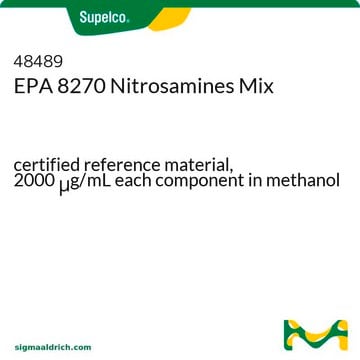B8061
N-Butyl-N-(4-hydroxybutyl)nitrosamine
ISOPAC®, ≥90% (GC)
Sinónimos:
BBN, N-Butyl-N-butan-4-ol-nitrosamine, N-Butyl-N-nitroso-4-aminobutanol
About This Item
Productos recomendados
assay
≥90% (GC)
form
liquid
storage temp.
2-8°C
InChI
1S/C8H18N2O2/c1-2-3-6-10(9-12)7-4-5-8-11/h11H,2-8H2,1H3
InChI key
DIKPQFXYECAYPC-UHFFFAOYSA-N
Application
Biochem/physiol Actions
Packaging
Caution
Reconstitution
Legal Information
signalword
Danger
hcodes
Hazard Classifications
Acute Tox. 4 Oral - Carc. 1B
Storage Class
6.1C - Combustible acute toxic Cat.3 / toxic compounds or compounds which causing chronic effects
wgk_germany
WGK 3
flash_point_f
296.6 °F
flash_point_c
147 °C
ppe
Eyeshields, Faceshields, Gloves, type ABEK (EN14387) respirator filter
Certificados de análisis (COA)
Busque Certificados de análisis (COA) introduciendo el número de lote del producto. Los números de lote se encuentran en la etiqueta del producto después de las palabras «Lot» o «Batch»
¿Ya tiene este producto?
Encuentre la documentación para los productos que ha comprado recientemente en la Biblioteca de documentos.
Nuestro equipo de científicos tiene experiencia en todas las áreas de investigación: Ciencias de la vida, Ciencia de los materiales, Síntesis química, Cromatografía, Analítica y muchas otras.
Póngase en contacto con el Servicio técnico









